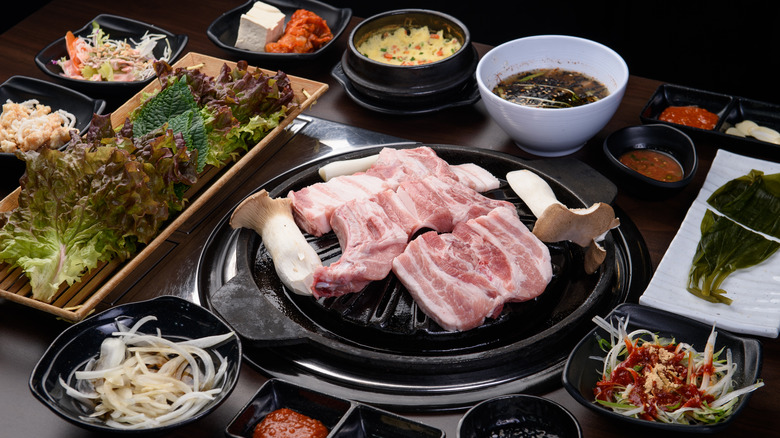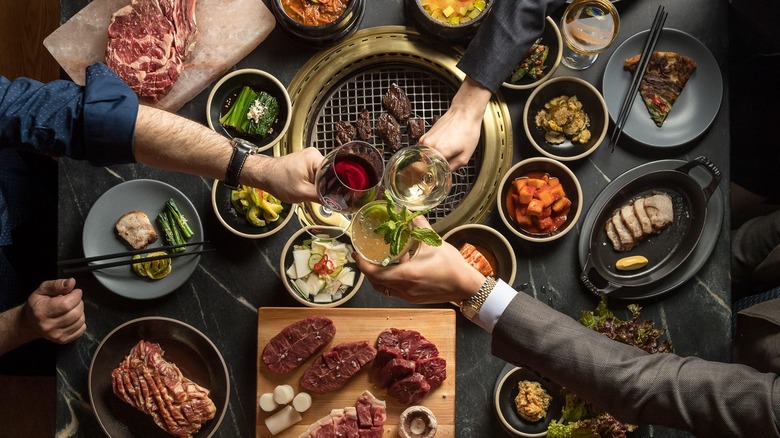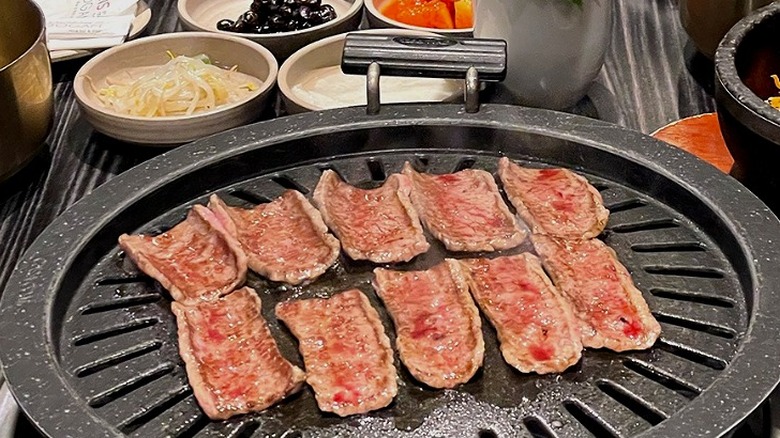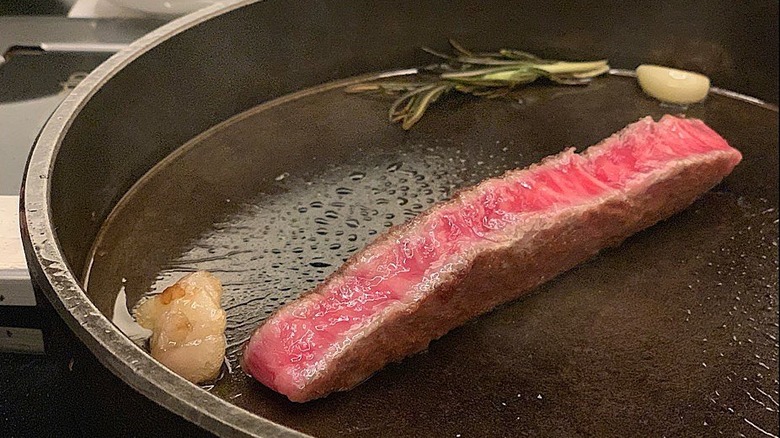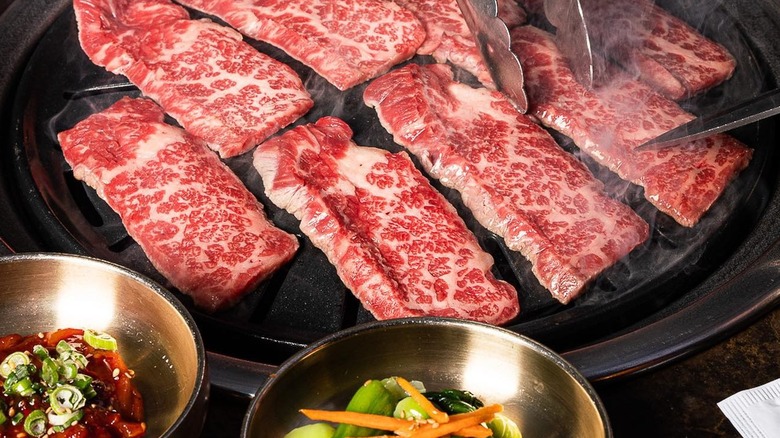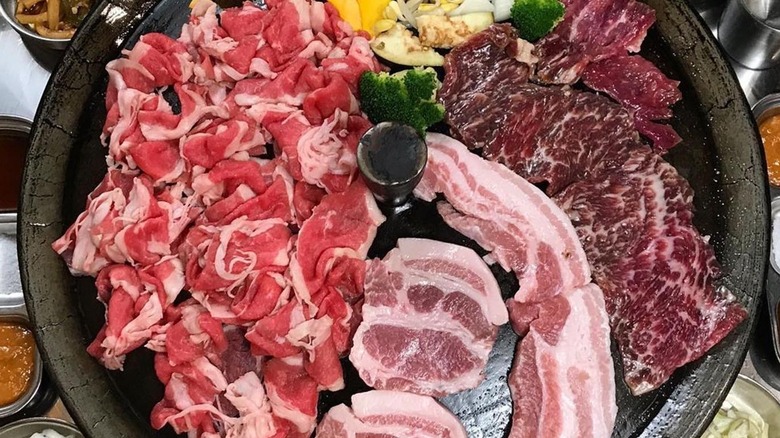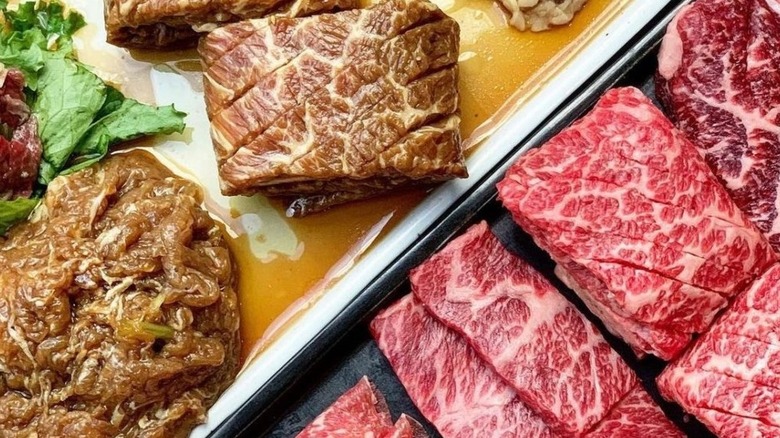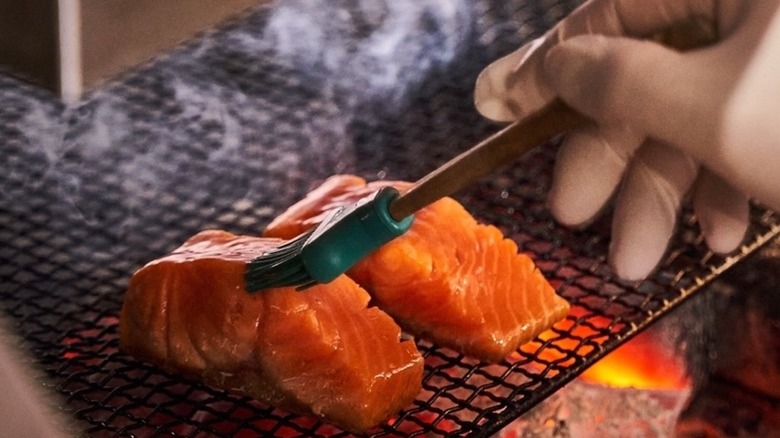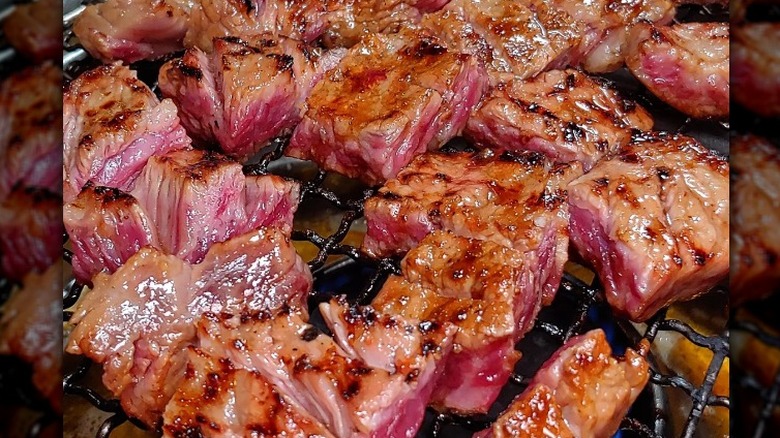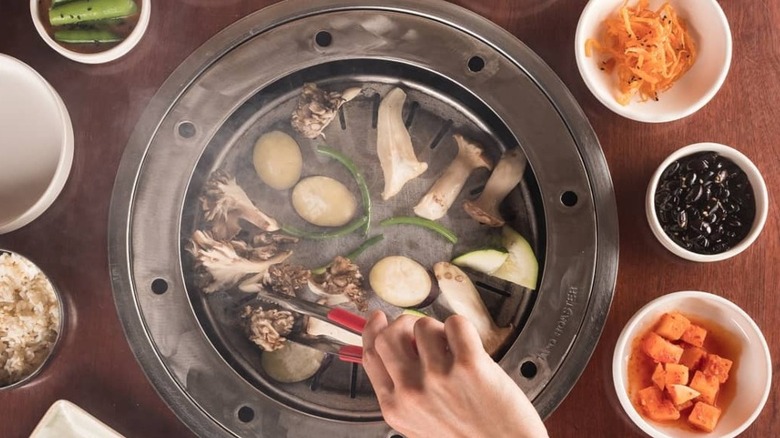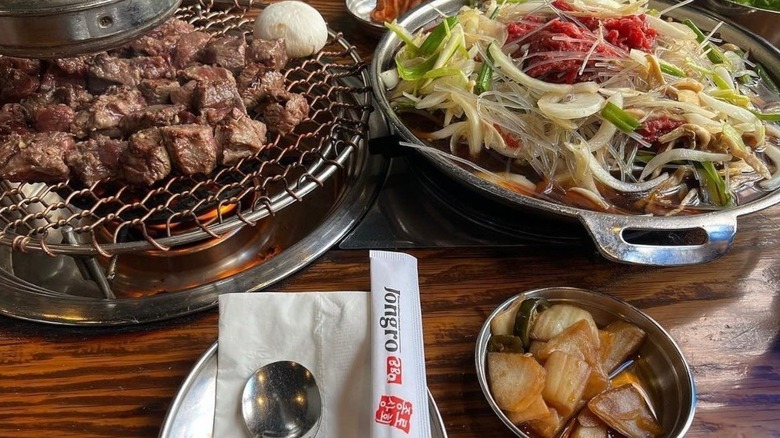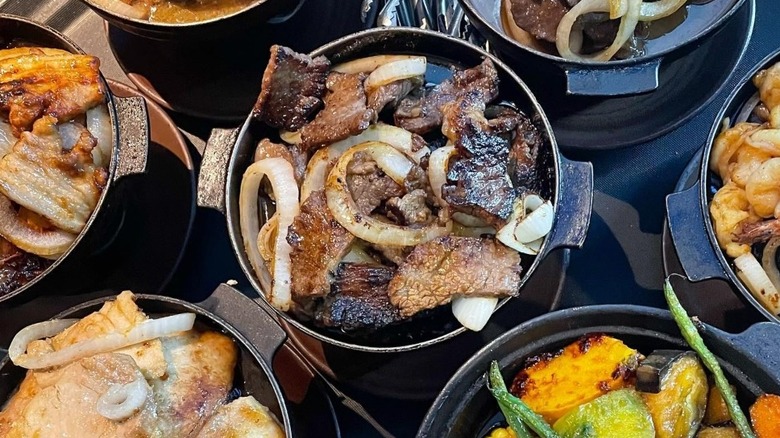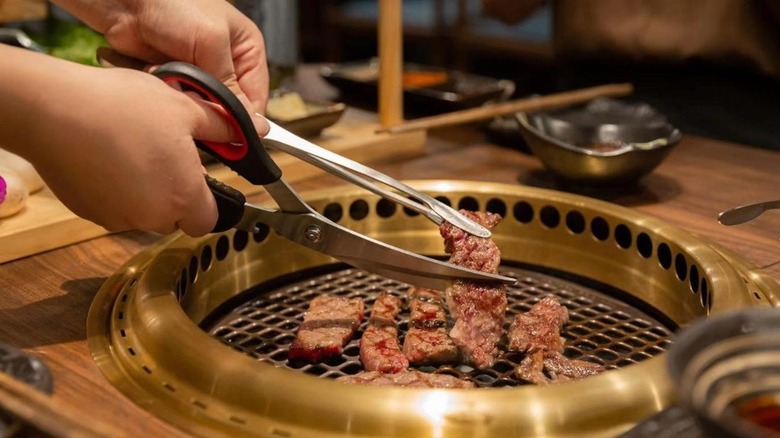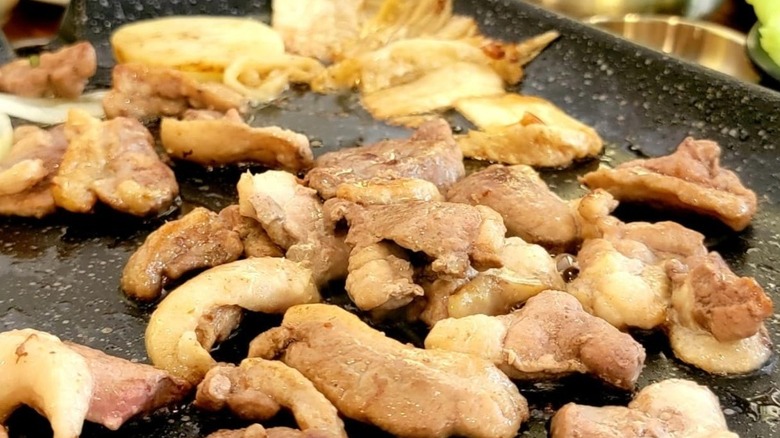13 Best Korean BBQ Restaurants In NYC
Before the influx of Korean barbecue establishments and the current wave of Michelin stars and accolades that accompanied them, New York City's Korean food scene laid the groundwork for the popularity that ensued. The story begins in the 1960s when, according to the Korean American Databank, the number of Korean restaurants in Manhattan rose from a modest four to a rapidly expanding eighteen over a decade. The Databank points out three main options on those early menus: traditional Korean fare for Korean ex-pats, an Americanized fusion menu called the "lunch special," and barbecue — mainly beef — for both Korean and American diners.
Even during Korean barbecue's humble beginnings in NYC, it's always been a favorite. The experience is unique in that you're just as likely to be cooking your meal as you are to be a spectator in its making. This culinary experience has moved far beyond the confines of delicious but casual street food offerings like Sotteok Sotteok, or Korean fried chicken, into accredited Michelin star territory. We've compiled a solid list of what we think are the best Korean barbecue restaurants in New York City right now. While Michelin has awarded not every restaurant on our list recognition, all of them offer a sumptuous barbecue experience that should be experienced if given the chance.
Cote Korean Steakhouse
First on the list is Cote Korean Steakhouse, which lauds itself, according to its homepage, as New York's first Korean steakhouse. Smokeless tabletop grills, prime cuts of USDA beef — dry-aged in-house — and an impressive selection of 1200-plus bottled wines awaits the carnivore seeking an NYC steakhouse experience beyond the usual filet mignon outing. According to The Korea Times, restaurateur Simon Kim was inspired by his tenure with celebrated Western chefs Jean-Georges Vongerichten and Thomas Keller to create a refined version of Korean barbecue that recalled Korea's aristocratic, high-end culinary traditions. In 2017, Cote Korean Steakhouse became a realization of that idea.
As part of the distinction of being awarded a Michelin star, the Michelin guide suggests trying the Butcher's Feast. Diving into Cote's menu, we learn the aforementioned feast includes four cuts of both USDA Prime and American Wagyu beef served with banchan (pickled seasonal vegetables), scallion salad, red leaf lettuce with ssamjang, egg souffle, a pair of stews (kimchi and dwenjang). And for dessert? Luxurious soft serve with soy sauce caramel. Under the expansive Meat, Meat & More Meat list, more options — including old favorites like filet mignon and New York strip — await.
According to reviews, the restaurant tends to be "buzzy and bustling" as evening turns to night, and Undercote, a downstairs lounge with plantlife, mood lighting, and chill beats, offers soju cocktails, wine, and yes, more food minus the grill.
Dons Bogam & Winebar
One of the best Korean bbq restaurants in the U.S., Dons Bogam BBQ & Wine Bar has been helmed by South Korean transplant Master Chef Woo Kim since 2006 when the founder K.R. Choi hired him as head chef.
The barbecue selection offers diners American Kobe beef, a cross between Japanese Wagyu and American black Angus cattle, according to Dons Bogam's menu. Mouthwatering beef platters make great use of spicy marinated short ribs, ribeye and skirt steaks, mushrooms, and beef brisket. Outside this wellspring, there's an excellent duck breast and a pork belly dish marinated in cabernet sauvignon that the Michelin Guide describes as "smokey and supremely tender." Pescatarians are also swimming in seafood options plates, with options that include shrimp, scallops, salmon, and lobster tails. Not to be ignored, vegetarians have their own options: a marinated mushroom platter with five different types of fungi.
As for ambiance, @nycityeats TikTok reveals a slick, well-lit dining room with scrumptious cuts of meat on tabletop grills, enjoyed by after-work crowds of happy people. A smorgasbord of red meat, seafood platters, vegetarian options, and a Michelin Star? There's no way we could leave Dons Bogam BBQ & Wine Bar off our list of best Korean barbecues in New York City.
Hyun
Jae Kim, the founder of Hyun, credits the launch of this high-end Korean restaurant to homesickness, according to The Villager. After moving to New York City in 2016, the restaurateur got to work, opening a spot in 2019 where diners would be treated to choice cuts of imported A5 Wagyu beef prepared by true experts. The cooking process involves each tableside grill master employing traditional Korean and modern principles together, expressed through the use of cast iron pans and electric induction as opposed to gas. There's a nod to tradition, while the newer electric induction offers faster, less carbon-inducing cooking. That means a more environmentally friendly barbecue experience with less wait time, and you don't have to take the scent of burning meat with you when you leave.
Forbes describes the interior in a way that points to a sleek and modern establishment with calming, natural earth tones — picture ash-gray walls and hardwood surfaces. Hyun's boasts an eight-seater chef's counter serving Omakase, which according to the Michelin Guide, borrows from a Japanese term that means "I leave it up to you." Aside from the tableside service, this decadent take on Korean barbecue — with Japanese Wagyu — also offers an all-you-can-eat option with buttery marbled slivers of silken beef in abundance.
With all of this in one place, how could this NYC Korean barbecue haunt not earn a Michelin star? Yes, a grilling experience with Wagyu beef is expensive but also worth it.
Antoya Korean BBQ
According to a press release on PRNewswire, Antoya Korean BBQ is the latest manifestation of an earlier restaurant called SamWon Garden, renamed Antoya after owner Tony Park's son Antonio. Yet another Michelin Star winner for two years running in 2020 and 2021, Tony Park's decision to change the name and direction of the restaurant was an epiphany related to the changing face of New York City and customers after the pandemic. "Our customers are, on average younger than before, and we need to provide a concept closer to their culture and to what they expect in terms of experience from a Korean BBQ," Park said in the release.
What that looks like, according to the Michelin Guide, is a three-story establishment packed with youthful energy, soundtracked by K-Pop anthems and the sizzle of quality meat over near smokeless gas-powered grills. One look at the Antoya menu, and it's clear the food is a fusion of Korean and Italian influences— a nod to Park's Italian upbringing and culinary expertise.
Here, you can expect unique barbecue combos like herbed rosemary lamb and Gangnam-style sausage next to more traditional beef (modeum so gui) and pork platters (modeum dweji gui). With accompaniments like egg souffle, truffle, and bacon, there's no way to go wrong with this NYC Korean barbecue spot.
Let's Meat BBQ
Koreatown's favorite, Let's Meat, is at the lower price point of NYC's Korean barbecue restaurants but doesn't lose much in quality, so it makes this list. One can make another brilliant case for why this belongs by taking a look at the Let's Meat menu. A set, all-you-can-eat offering gives diners 100-minute group seatings for under $50. According to Secret NYC, as of 2020, Let's Meat had the distinction of being the first all-you-can-eat Korean barbecue restaurant in Manhattan, an experience you can taste through the blissful barbecue provided.
Some items on the grill include thinly sliced ribeye, Berkshire pork belly, chicken breast, and short ribs cooked over an imported Cap-Style grill. This last part is important, as the fashion of cookware is renowned for its special ability to grill the greasiness out of any cut of meat, according to the Let's Meat site. But before going all out on the AYCE options, just know that there's an extra charge applied for unfinished meat, and there are no takeout options. So although it's relatively cheap and cheerful, self-restraint is advised. At this price, we can afford to go back to try whatever was missed the last time around.
Yoon Haeundae Galbi
When discussing the origins of Yoon Haeundae Galbi, the restaurant reveals its existence was an attempt to honor the owner's Korean grandfather, who launched the original restaurant in Haeundae, Busan, South Korea, in 1964. Two generations of ownership later, Bobby Yoon created a New York flagship location where traditional methods of Korean cooking are still respected and enjoyed by a captive American audience.
This includes his grandfather's method of tenderizing meats, like short ribs, called the "Haeundae Cut." The New York Times describes this as a technique where the meat is first cut along the grain instead of against it, then cut against the grain to break down sinew that threatens to lead to tough, chewy cuts. It's then heated on a grill set into the tabletop until the fat is rendered and leaves moist, velvety cuts of meat with charbroiled edges. Speaking of cuts, aside from delicious short rib, there's also dry-aged ribeye, NY strip, and brisket among the menu items.
Walking into the restaurant is a welcoming experience. A cavernous establishment with warm lighting and colors provided by brass lining against dark concrete and wooden panels, an emerald bar adorned with speckled grey countertops, and columns with intimate banquette group seating await the adventurous. This is a New York barbecue experience where eating with your eyes is about more than just the meat.
Jua
There's a clear pattern of Korean restauranteurs in New York naming establishments after family members, and Jua is no exception. Named after chef and owner Hoyoung Kim's daughter, according to Jua's website, the title is an offshoot of the French joie, meaning joy. The classically trained graduate of the Parisian culinary school Ecole Ferrandi is a two-time Michelin Star winner as the past chef of Jungsik. For Jua, he brings all that talent in the form of a seven-course tasting menu over a wood fire.
That's right, there's no gas grilling or electric induction here, but instead, look for impeccably made Korean-style barbecue in an upscale environment. The New Yorker describes it as an opulent hangout for the moneyed classes with the heady scent of spiced firewood in the air. There's a very good chance some of that spice gets in the barbecue, and for the hefty $130 price tag attached to the privilege, it should. This isn't going to be your after-work go-to situation (unless you're a resident of Manhattan's Billionaire's Row), but this is definitely how you do Korean barbecue for a special occasion like a birthday or anniversary.
Among the seven items on the current tasting menu (as of December 2022), some of the more interesting include caviar kimbap, seafood like smoked mackerel, and grilled duck breast. Located in Tribeca, steps away from Wall Street, Jua is a Korean barbecue that screams excess — but sometimes, that's needed.
Baekjeong NYC
Baekjong stems from the Korean word for "butcher," which indicates the carnivorous grilling skills on display at this stalwart Koreatown establishment. Baekjeong has been visited by celebrities like Questlove, Venus Williams, and Serena Williams, as evidenced by a scrolling gallery proudly displayed on its homepage.
According to the New York Post, it's been a favorite of top-tier industry players, including Momofuko's David Chang and the late great Anthony Bourdain, which is pretty high praise for any restaurant. Unlike some of the higher-echelon restaurants on this list, Baekjong's menu mostly steers from fusion or unusual ingredients, preferring to lean into standard Korean barbecue fare.
The popularity has allowed this restaurant to become a North American chain with outlets in Edmonton and Calgary, Canada. Baekjong has an ebullient, clubby ambiance where the hubbub of a packed dining crowd competes with music pumping out speakers. This is where patrons go for Prime USDA beef and a party into the late hours.
Classic cuts of Korean barbecue bliss, like marinated and boneless short rib or Wagyu flat iron steak and thinly sliced brisket, jostle for attention next to lesser-known pork jowl, beef tongue, and crispy pork skin. The combo platters offer large groups an opportunity to try a little of everything and definitely make the trip to Koreatown more than worth it.
Insa Brooklyn
According to FSR Magazine, husband and wife team Chef Sohui Kim and designer Ben Schneider launched Insa in 2015 to provide Brooklynites with a taste of real Korean barbecue based on sustainability and seasonality. With an interior designed by Schneider, what you get is a 100-seat establishment inspired by Korean iconography and aesthetics in the form of modern curves, archways, and lighting.
Insa's menu is exactly what you would expect from an ecologically conscious Brooklyn-based diner — BBQ items listed with both qualifiers: the meat being grilled and where said meat is sourced from. There are a few traditional items here: dry-aged ribeye from Happy Valley Meat Co; samgyupsal, otherwise known as thick cuts of heritage pork belly; galbi, the requisite portion of marinated beef short rib served in every Korean barbecue spot in New York. For an extra $5, you can choose five curated and refillable barbecue sides (banchan), like fresh napa kimchi and potato salad.
When dinner is over, we suggest traipsing over to one of five private karaoke dens, each with a unique theme. Work off your short ribs by dancing and enthusiastically belting out a proper 80s power ballad over a soju cocktail.
Jongro BBQ
A stroll into Jongro BBQ is like walking into a different time and space — 1985 Seoul, to be exact. Vintage Korean movie posters and kitschy signage with Korean lettering decorating the entrance. An original South Korean transplant, Jongro officially became a chain once it landed in NYC in 2015. The establishment's popularity means wait times for a seat are very likely, but at least the staff is considerate enough to take menu orders while waiting. A wait for a table in exchange for a fast barbecue is a trade-off we can live with.
Jongro BBQ is quick to point out that it eschews frozen meat of any kind, and the fresh quality cuts of meat delivered daily are butchered, marinated, and grilled in-house. At Jongro BBQ, barbecue isn't just a way of life but also a practice that's been boiled down to a science. So scientific, in fact, the restaurant employs laser thermometers and overhead smoke lamps to make sure all the meat stays at the right temperature to regulate and ensure quality.
That dedication to freshness is impressive, and so are the grill offerings. One of the most popular menu items is the beef platter — brisket, skirt steak, ribeye, marinated chuck, and short rib capped with a complete list of traditional sides.
The Woo
No, The Woo has nothing to do with The WuTang Clan, although you could be forgiven for thinking there's an association. The Woo, a two-story establishment in Soho with smokeless grills and a design straddling the modern and traditional, describes itself as a contemporary Korean restaurant focused on the authentic flavors of Korea. Decorated in floor-to-ceiling wood accents and accompanied by tables separated with shimmering beaded curtains, The Woo looks exactly like what you would expect from an area of the city known for its art galleries.
According to The New York Times, the name is related to the name of the original restaurant launched in 1999, Woo Lae Oak, which was owned by the mother of the current owner's iteration of the restaurant, third-generation restaurateur Julie Choi. This history extends back to Seoul, South Korea, and her grandmother, who brought the concept to New York in 1974. Three generations of Korean barbecue knowledge can only lead to great things.
Gan-Hoo BBQ
Gan-Hoo BBQ makes no bones about what it is and how it does it. This barbecue fusion restaurant in Flushing, Queens, borrows from only the best elements of Korean and Japanese barbecue. Unlike the other restaurants on this list, according to the Queen's Chamber of Commerce, Gan-Hoo's barbecue is cooked on tilted crystal grills, with the meat situated above kimchi. The idea is to ensure the meaty barbecue essence — which receives an even char on crystal — flavors every bite of kimchi that accompanies it.
What does this Korean-Japanese fusion look like on your plate? Mugifuji pork, which Anzu Meat Factory explains as coming from Canadian pigs raised under specific Japanese guidelines, lends to a fattier, juicer cut. The primary supplier of meat in Japan and North America writes that mugifuji appears at Gan-Hoo as a thick-cut pork belly grilled to perfection in Korean style. Wagyu beef tongue leans into the Korean beef tongue standard but substitutes USDA Prime beef for another premium Japanese meat, Wagyu.
With several great group combos and a unique fusion flare, Gan-Hoo earns a spot on this list for originality and ingenuity.
Daori
Last on our list is Daori, a traditional Korean barbecue with favorites like marinated grilled duck and chicken, marinated pork and beef ribs, and Angus ribeyes. Ironically, the traditional nature of Daori probably makes it the first place a Korean barbecue novice should start an education on everything regarding Korean barbecue. Although everything on the barbecue menu is great, Daori shines where duck meat is concerned. Grilled duck (sang ori gui), Korean marinated and grilled duck (ori jumulleok), and a spicy Korean marinated grilled duck all make the bill. (And no, there are no duck bills on offer.)
A gander at Daori's Instagram reveals a downhome but professional restaurant with veteran grill masters expertly preparing beautiful, smoky cuts of meat on metal tabletop grills. A bright, airy space with Korean-style wooden accents and happy diners, this is the sort of neighborhood haunt that locals clamor to. We don't need any more reason than that to try it out.
